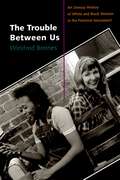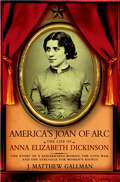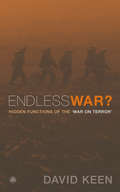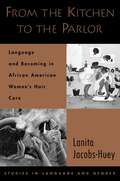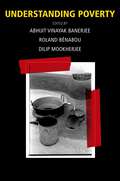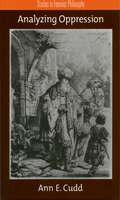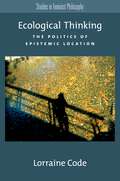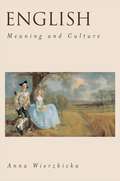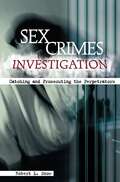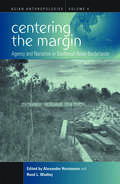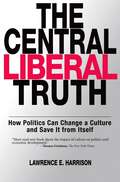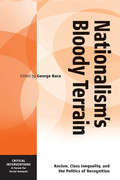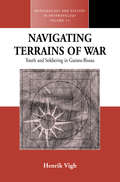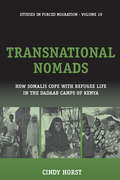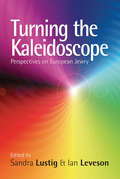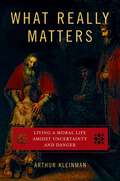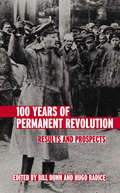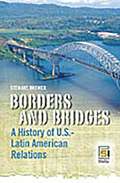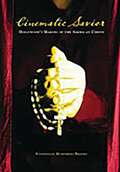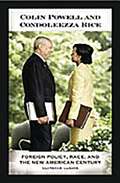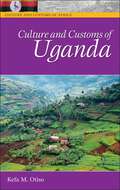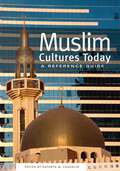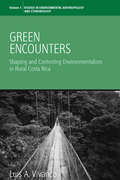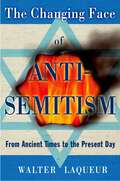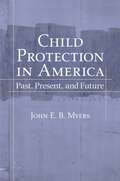- Table View
- List View
The Trouble Between Us: An Uneasy History of White and Black Women in the Feminist Movement
by Winifred BreinesInspired by the idealism of the civil rights movement, the women who launched the radical second wave of the feminist movement believed, as a bedrock principle, in universal sisterhood and color-blind democracy. Their hopes, however, were soon dashed. To this day, the failure to create an integrated movement remains a sensitive and contested issue. In The Trouble Between Us, Winifred Breines explores why a racially integrated women's liberation movement did not develop in the United States. Drawing on flyers, letters, newspapers, journals, institutional records, and oral histories, Breines dissects how white and black women's participation in the movements of the 1960s led to the development of separate feminisms. Herself a participant in these events, Breines attempts to reconcile the explicit professions of anti-racism by white feminists with the accusations of mistreatment, ignorance, and neglect by African American feminists. Many radical white women, unable to see beyond their own experiences and idealism, often behaved in unconsciously or abstractly racist ways, despite their passionately anti-racist stance and hard work to develop an interracial movement. As Breines argues, however, white feminists' racism is not the only reason for the absence of an interracial feminist movement. Segregation, black women's interest in the Black Power movement, class differences, and the development of identity politics with an emphasis on "difference" were all powerful factors that divided white and black women. By the late 1970s and early 1980s white feminists began to understand black feminism's call to include race and class in gender analyses, and black feminists began to give white feminists some credit for their political work. Despite early setbacks, white and black radical feminists eventually developed cross-racial feminist political projects. Their struggle to bridge the racial divide provides a model for all Americans in a multiracial society.
America's Joan of Arc: The Life of Anna Elizabeth Dickinson
by J. Matthew GallmanOne of the most celebrated women of her time, a spellbinding speaker dubbed the Queen of the Lyceum and America's Joan of Arc, Anna Elizabeth Dickinson was a charismatic orator, writer, and actress, who rose to fame during the Civil War and remained in the public eye for the next three decades. J. Matthew Gallman offers the first full-length biography of Dickinson to appear in over half a century. Gallman describes how Dickinson's passionate patriotism and fiery style, coupled with her unabashed abolitionism and biting critiques of antiwar Democrats--known as Copperheads--struck a nerve with her audiences. In barely two years, she rose from an unknown young Philadelphia radical, to a successful New England stump speaker, to a true national celebrity. At the height of her fame, Dickinson counted many of the nation's leading reformers, authors, politicians, and actors among her friends. Among the dozens of famous figures who populate the narrative are Susan B. Anthony, Whitelaw Reid, William Lloyd Garrison, Frederick Douglass, Elizabeth Cady Stanton, and Harriet Beecher Stowe. Gallman shows how Dickinson's life illuminates the possibilities and barriers faced by nineteenth-century women, revealing how their behavior could at once be seen as worthy, highly valued, shocking, and deviant.
Endless War?: Hidden Functions of the 'War on Terror'
by David KeenWas the Iraq war really an act of goodwill to liberate people from injustice? Or was it a strategic move to maintain US dominance globally? *BR**BR*This book casts a critical light on the real motives behind war and conflict. David Keen explores how winning war is rarely an end in itself; rather, war tends to be part of a wider political and economic game that is consistent with strengthening the enemy. Keen devises a radical framework for analysing an unending war project, where the 'war on terror' is an extension of the Cold War.*BR**BR*The book draws on the author's detailed study of wars in Sudan, Sierra Leone, as well as in a range of other conflicts.
From the Kitchen to the Parlor: Language and Becoming in African American Women's Hair Care (Studies in Language and Gender)
by Lanita Jacobs-HueyWhen is hair "just hair" and when is it not "just hair"? Documenting the politics of African American women's hair, this multi-sited linguistic ethnography explores everyday interaction in beauty parlors, Internet discussions, comedy clubs, and other contexts to illuminate how and why hair matters in African American women's day-to-day experiences.
Understanding Poverty
by Abhijit Vinayak Banerjee Roland Benabou Dilip MookherjeeUnderstanding poverty and what to do about it, is perhaps the central concern of all of economics. Yet the lay public almost never gets to hear what leading professional economists have to say about it. This volume brings together twenty-eight essays by some of the world leaders in the field, who were invited to tell the lay reader about the most important things they have learnt from their research that relate to poverty. The essays cover a wide array of topics: the first essay is about how poverty gets measured. The next section is about the causes of poverty and its persistence, and the ideas range from the impact of colonialism and globalization to the problems of "excessive" population growth, corruption and ethnic conflict. The next section is about policy: how should we fight poverty? The essays discuss how to get drug companies to produce more vaccines for the diseases of the poor, what we should and should not expect from micro-credit, what we should do about child labor, how to design welfare policies that work better and a host of other topics. The final section is about where the puzzles lie: what are the most important anomalies, the big gaps in the way economists think about poverty? The essays talk about the puzzling reluctance of Kenyan farmers to fertilizers, the enduring power of social relationships in economic transactions in developing countries and the need to understand where aspirations come from, and much else. Every essay is written with the aim of presenting the latest and the most sophisticated in economics without any recourse to jargon or technical language.
Analyzing Oppression (Studies in Feminist Philosophy)
by Ann E. CuddAnalyzing Oppression presents a new, integrated theory of social oppression, which tackles the fundamental question that no theory of oppression has satisfactorily answered: if there is no natural hierarchy among humans, why are some cases of oppression so persistent? Cudd argues that the explanation lies in the coercive co-opting of the oppressed to join in their own oppression. This answer sets the stage for analysis throughout the book, as it explores the questions of how and why the oppressed join in their oppression. Cudd argues that oppression is an institutionally structured harm perpetrated on social groups by other groups using direct and indirect material, economic, and psychological force. Among the most important and insidious of the indirect forces is an economic force that operates through oppressed persons' own rational choices. This force constitutes the central feature of analysis, and the book argues that this force is especially insidious because it conceals the fact of oppression from the oppressed and from others who would be sympathetic to their plight. The oppressed come to believe that they suffer personal failings and this belief appears to absolve society from responsibility. While on Cudd's view oppression is grounded in material exploitation and physical deprivation, it cannot be long sustained without corresponding psychological forces. Cudd examines the direct and indirect psychological forces that generate and sustain oppression. She discusses strategies that groups have used to resist oppression and argues that all persons have a moral responsibility to resist in some way. In the concluding chapter Cudd proposes a concept of freedom that would be possible for humans in a world that is actively opposing oppression, arguing that freedom for each individual is only possible when we achieve freedom for all others.
Ecological Thinking: The Politics of Epistemic Location (Studies in Feminist Philosophy)
by Lorraine CodeHow could ecological thinking animate an epistemology capable of addressing feminist, multicultural, and other post-colonial concerns? Starting from an epistemological approach implicit in Rachel Carson's scientific practice, Lorraine Code elaborates the creative, restructuring resources of ecology for a theory of knowledge. She critiques the instrumental rationality, abstract individualism, and exploitation of people and places that western epistemologies of mastery have legitimated, to propose a politics of epistemic location, sensitive to the interplay of particularity and diversity, and focused on responsible epistemic practice. Drawing on ecological theory and practice, on naturalized epistemology, and on feminist and post-colonial theories, Code analyzes extended examples from developmental psychology, and from two "natural" institutions of knowledge production--medicine and law. These institutions lend themselves well to a reconfigured naturalism. They are, in practice, empirically-scientifically informed, specifically situated, and locally interpretive. With human subjects as their "objects" of knowledge, they invoke the responsibility requirements central to Code's larger project. This book discusses a wide range of literature in philosophy, social science, and ethico-political thought. Highly innovative, it will generate productive conversations in feminist theory, and in the ethics and politics of knowledge more broadly conceived.
English: Meaning and Culture
by Anna WierzbickaIt is widely accepted that English is the first truly global language and lingua franca. Anna Wierzbicka, the distinguished linguist known for her theories of semantics, has written the first book that connects the English language with what she terms "Anglo" culture. Wierzbicka points out that language and culture are not just interconnected, but inseparable. She uses original research to investigate the "universe of meaning" within the English language (both grammar and vocabulary) and places it in historical and geographical perspective. This engrossing and fascinating work of scholarship should appeal not only to linguists and others concerned with language and culture, but the large group of scholars studying English and English as a second language.
Sex Crimes Investigation: Catching and Prosecuting the Perpetrators
by Robert L. SnowNo one wants to be robbed at gunpoint, or have his car stolen, or his house robbed. When these crimes happen, victims may feel angry, afraid, or violated. But there is no violation quite so devastating as sexual assault. Victims do not recover easily—either emotionally, psychologically, or physically from such incidents, and the long-term impact can have devastating effects on the victims, their families, and communities. Investigating sexually based crimes is particularly difficult for many reasons. Often the collection of evidence requires a medical examination of the victim—a second violation of sorts. Police must interview the victim, who must recount his or her assault. Often, the victims are children, and offenders range from family members to perfect strangers. But investigating and prosecuting these crimes is crucial to the healing process of many victims, and to the safety of society at large.Detective Snow takes readers on a tour of the ways in which the police investigate and help prosecute such crimes. Each chapter begins with a real-life incident and throughout the book real stories are used to illustrate each step in the process. Snow addresses the processing of the crime scene, the collection of evidence, the development of suspects, the questioning of witnesses and perpetrators, and the preparation for trial. Few members of the public have any idea how complex and delicate the investigation of sex crimes really is. This book sheds light on this important police work and helps readers understand how these crimes are investigated, solved, and prosecuted. Victims and their families will especially benefit from the information in this book, but all readers will gain insight into the crimes, their incidence, their impact on victims, and the way the criminal justice system responds, from the scene of the crime through the capture and incarceration of the perpetrators.
Centering the Margin: Agency and Narrative in Southeast Asian Borderlands (Asian Anthropologies #4)
by Alexander Horstmann Reed L. WadleyIn a completely new approach to borders and border crossing, this volume suggests a re-conceptualization of the nation in Southeast Asia. Choosing an actor approach, the individual chapters in this volume capture the narratives of minorities, migrants and refugees who inhabit and cross borders as part of their everyday life. They show that people are not only constrained by borders; the crossing of borders also opens up new options of agency. Making active use of these, border-crossing actors construct their own live projects on the border in multiple ways against the original intention of the nation-state. Based on their intimate knowledge of the interaction of communities, anthropologists from Europe, the USA, Japan and Southeast Asia provide a vivid picture of the effects of state policies at the borders on these communities.
The Central Liberal Truth: How Politics Can Change a Culture and Save It from Itself
by Lawrence E. HarrisonWhich cultural values, beliefs, and attitudes best promote democracy, social justice, and prosperity? How can we use the forces that shape cultural change, such as religion, education, and political leadership, to promote these values in the Third World--and for underachieving minorities in the First World? In this book, Lawrence E. Harrison offers intriguing answers to these questions, in a valuable follow-up to his acclaimed Culture Matters. Drawing on a three-year research project that explored the cultural values of dozens of nations--from Botswana, Sweden, and India to China, Egypt, and Chile--Harrison offers a provocative look at values around the globe, revealing how each nation's culture has propelled or retarded their political and economic progress. The book presents 25 factors that operate very differently in cultures prone to progress and those that resist it, including one's influence over destiny, the importance attached to education, the extent to which people identify with and trust others, and the role of women in society. Harrison pulls no punches, and many of his findings are controversial. Contradicting the arguments of multiculturalists, this book contends that when it comes to promoting human progress, some cultures are clearly more effective than others. It convincingly shows which values, beliefs, and attitudes work and how we can foster them. "Harrison takes up the question that is at the center of politics today: Can we self-consciously change cultures so they encourage development and modernization?" --David Brooks, New York Times "I can think of no better entrance to the topic, both for what it teaches and the way it invites and prepares the reader to continue. A gateway study." --David S. Landes, author of The Wealth and Poverty of Nations
Nationalism's Bloody Terrain: Racism, Class Inequality, and the Politics of Recognition (Critical Interventions: A Forum for Social Analysis #8)
As many scholars have argued, racism and its passions are created by and subordinated to the nation. This volume places the practices of racism at the center of analysis of so-called post-racist or multi cultural nation-states. This way, each contributor analytically treats racism and its related concepts of race, identity, culture, and naturalizing symbols of blood to highlight the manner in which governing institutions use nationalist precepts to create "races". In the end, it is racism - the actual political practices of domination - that makes "race" salient, especially in its multi-cultural and liberal-democratic form.
Navigating Terrains of War: Youth and Soldiering in Guinea-Bissau (Methodology & History in Anthropology #13)
by Henrik E. VighThrough the concept of "social navigation," this book sheds light on the mobilization of urban youth in West Africa. Social navigation offers a perspective on praxis in situations of conflict and turmoil. It provides insights into the interplay between objective structures and subjective agency, thus enabling us to make sense of the opportunistic, sometimes fatalistic and tactical ways in which young people struggle to expand the horizons of possibility in a world of conflict, turmoil and diminishing resources.
Transnational Nomads: How Somalis Cope with Refugee Life in the Dadaab Camps of Kenya (Forced Migration #19)
by Cindy HorstThere is a tendency to consider all refugees as 'vulnerable victims': an attitude reinforced by the stream of images depicting refugees living in abject conditions. This groundbreaking study of Somalis in a Kenyan refugee camp reveals the inadequacy of such assumptions by describing the rich personal and social histories that refugees bring with them to the camps. The author focuses on the ways in which Somalis are able to adapt their 'nomadic' heritage in order to cope with camp life; a heritage that includes a high degree of mobility and strong social networks that reach beyond the confines of the camp as far as the U.S. and Europe.
Turning the Kaleidoscope: Perspectives on European Jewry
by Sandra Lustig Ian LevesonFar from being a blank space on the Jewish map, or a void in the Jewish cultural world, post-Shoah Europe is a place where Jewry has continued to develop, even though it is facing different challenges and opportunities than elsewhere. Living on a continent characterized by highly diverse patterns of culture, language, history, and relations to Jews, European Jewry mirrors that kaleidoscopic diversity. This volume explores such key questions as the new roles for Jews in Europe; models of Jewish community organization in Europe; concepts of diaspora and galut; a European-Jewish way of life in the era of globalization; and European Jews' relationship to Israel and to non-Jews. Some contributions highlight experiences of Jews in Britain, Sweden, Norway, Hungary, Austria, Germany, and the Netherlands. Helping us to understand the special and common characteristics of European Jewry, this collection offers a valuable contribution to the continued rebuilding of Jewish life in the postwar era.
What Really Matters: Living a Moral Life amidst Uncertainty and Danger
by Arthur KleinmanIn this moving and thought-provoking volume, Arthur Kleinman tells the unsettling stories of a handful of men and women, some of whom have lived through some of the most fundamental transitions of the turbulent twentieth century. Here we meet an American veteran of World War II, tortured by the memory of the atrocities he committed while a soldier in the Pacific. A French-American woman aiding refugees in sub-Saharan Africa, facing the utter chaos of a society where life has become meaningless. A Chinese doctor trying to stay alive during Mao's cultural revolution, discovering that the only values that matter are those that get you beyond the next threat. These individuals found themselves caught in circumstances where those things that matter most to them--their desires, status, relationships, resources, political and religious commitments, life itself--have been challenged by the society around them. Each is caught up in existential moral experiences that define what it means to be human, with an intensity that makes their life narratives arresting. These stories reveal just how malleable moral life is, and just how central danger is to our worlds and our livelihood. Indeed, Kleinman offers in this book a groundbreaking approach to ethics, examining "who we are" through some of the most disturbing issues of our time--war, globalization, poverty, social injustice--all in the context of actual lived moral life.
100 Years of Permanent Revolution: Results and Prospects
by Bill Dunn Hugo RadiceOne hundred years on from their first appearance in Leon Trotsky's Results and Prospects, this is a critical re-evaluation of two key Marxist theories: uneven and combined development, and permanent revolution. It brings together a formidable array of Marxist intellectuals from across the world including Daniel Bensaid, Michael Löwy, Hillel Ticktin and Patrick Bond.*BR**BR*Marx saw societies progressing through distinct historical stages – feudal, bourgeois and communist. Trotsky advanced this model by considering how countries at different stages of development influence each other. Developed countries colonise less developed countries and exploit their people and resources. Elsewhere, even as many were kept in poverty, the influence of foreign capital and state-led industrialisation produced novel economic forms and prospects for political alliances and change. *BR**BR*The contributors show how, 100 years on from its original publication, Trotsky's theories are hugely useful for understanding today's globalised economy, dominated by US imperialism.
Borders and Bridges: A History of U.S.-Latin American Relations (Praeger Security International)
by Stewart BrewerThe symbiotic relationship between the United States and Latin America has been filled with bitterness and anguish, on the one hand, and hope and cooperation, on the other. Each provides something the other lacks, and thus the relationship has the potential to work to the advantage of both. Brewer provides an introduction to the most important events in the diplomatic, military, social, and economic history of the relationship between the United States and countries of Latin America.The symbiotic relationship between the United States and Latin America has been filled with bitterness and anguish, on the one hand, and hope and cooperation, on the other. Each provides something the other lacks, and thus the relationship has the potential to work to the advantage of both. Brewer provides an introduction to the the most important events in the diplomatic, military, social, and economic history of the relationship between the United States and countries of Latin America.Soon after the American Revolutionary War, the new nation needed to build a solid relationship with Latin American countries in order to survive. The apex of hemispheric relations was not reached until World War II, when the area witnessed an unprecedented level of cooperation and mutual collaboration. This era ended with the onset of the Cold War, when the competition between capitalism and communism was fought by proxy throughout the developing world, adversely affecting the ability of Latin American nations to develop independent identities or thriving economies. Brewer argues that the events of 9/11 changed this relationship very little. Indeed, many of the issues that have long plagued U.S.-Latin American relations are returning as the United States focuses on the War on Terror in the Middle East and neglects its southern neighbors.
Cinematic Savior: Hollywood's Making of the American Christ
by Stephenson Humphries-BrooksFrom Cecil B. DeMille's production of King of Kings in 1927, to Mel Gibson's recent The Passion of the Christ, films that discuss the meaning of Jesus have provoked interest, discussion, and reevaluation on a large scale. Hollywood films that deal with this subject have consistently managed to augment their inherent power by commenting simultaneously on political and cultural matters, and drawing from alternative cultural and mythological sources. The Greatest Story Ever Told, for instance, uses a landscape similar to that of the American West, while The Last Temptation of Christ deals with themes related to modern American notions of sexuality and sin. This timely examination considers the life of Jesus as it has been portrayed in such films as King of Kings, The Greatest Story Ever Told, Jesus of Nazareth, The Last Temptation of Christ, and The Passion of the Christ, as well as the more allusive and implicit use of Christ-related themes in Spartacus, Shane, and The Matrix. It looks at the diverse content and often-surprising impact of these and other films, and reveals how these depictions have helped determine, and been determined by, particularly American notions of who Jesus was, how he lived and died, and what he means for both our religious and secular cultures.Through an objective consideration of these movies, the emergent religious culture of mainstream American film becomes apparent as a central element in Hollywood movies—and in American popular culture at large.
Colin Powell and Condoleezza Rice: Foreign Policy, Race, and the New American Century
by Clarence LusaneLusane has created a groundbreaking analysis of the intersection of racial politics and American foreign policy. This insightful work critically examines the roles played by former Secretary of State Colin Powell and current Secretary of State (and former National Security Advisor) Condoleezza Rice in the construction of U.S. foreign policy, exploring the ways in which their racial identity challenges conventional notions about the role of race in international relations.Neither Powell nor Rice consciously allowed their racial identity to substantially influence or characterize their participation in the defense and projection of U.S. hegemony, Lusane argues, but both used their racial identity and experiences strategically in key circumstances to defend Bush administration policies. This is but one sense in which their race, despite their reluctance to be seen as racial figures, is significant in relation to U.S. foreign policy.Locating Powell and Rice within the genealogy of the current national security strategy, and within broader shifts under George W. Bush, this work argues that their racial location in the context of the construction of U.S. foreign policy is symbolic, and that it serves to distract from the substantive part they play in the ongoing reconfiguration of U.S. global power. Criticism of Powell's and Rice's policies, for example, is often blunted by race. Black liberals may be reluctant to condemn them, while white liberals may be afraid criticism could be interpreted as racial bias, especially since conservatives of both races argue that such criticism is probably racist. Lusane tackles these difficult issues along with others, asking whether there is a black consensus on foreign policy and, if so, what its dimensions, driving forces, and prospects for stability are. How can a progressive alternative to the current U.S. foreign policy be realized? Are Powell and Rice merely functionaries, or did they substantially determine the direction of U.S. foreign policy? What will their legacies be?
Culture and Customs of Uganda (Culture and Customs of Africa)
by Kefa M. OtisoSince achieving independence from Great Britain in 1962, the East African country of Uganda has been ravaged by political turmoil and the more recent crisis of the AIDS epidemic, but is now in the process of rebuilding and democratizing. Culture and Customs of Uganda is a fascinating overview of the current state of Ugandan society, where largely rural ethnic groups are experiencing the pull of urban centers, while the changes brought about by Western influences bear on practically every aspect of people's lives. Examples from the main ethnic groups are used to explain traditional culture and adaptations to modern life in religion, gender roles, courtship and marriage, work, education, family life, ceremonies, the arts, media, and more. This is the essential reference source to turn to for solid insight into Uganda.The wealth of detail in the coverage of the subjects above plus the land, people, history, literature, architecture/housing, cuisine, dress, gender roles, social customs and lifestyle, provides readers with broad sense of the country and its inhabitants. The sensitive narrative conveys the nuances between old and new, urban and rural, elite and poor for each topic. In addition, the evolution of Ugandan peoples is superbly demonstrated. Highlights include a discussion of the ways in which adherents of world religions such as Christianity and Islam mix these with traditional African religious belief in spirits, diviners, and rainmakers. The book also explores patriarchy and the social and inheritance system that has hindered women's education and prospects and exposed them to HIV/AIDS. Finally, there is a celebration of the various forms of artistic expression, such as drumming, ceremonial dance, and handicrafts, particularly ceramic pottery, that have won accolades, as well as a look at artists who excel in writing poetry, producing hip-hop, and painting batiks for popular consumption.
Muslim Cultures Today: A Reference Guide
by Kathryn M. CoughlinThere is strong demand for current, accurate, and objective information about Islamic societies and Muslims around the world. This is the first survey for a general audience of key current topics in 16 countries with significant Muslim populations. Each chapter covering a country contains the following narrative elements: Overview (statistics, demographics of followers, brief history of their life there); Political Impact; Women's Status; Special Issues in the News; Notable People (biographical profiles); and Resource Guide, with Suggested Reading, Films/Videos, Websites, and Organizations. The content ties in to World History standards to help analyze connections between globalizing trends in culture in the late 20th century and dynamic assertions of traditional cultural identity and distinctiveness, as well as to the Global Connections part of Social Studies standards.This will be essential reading for those desiring a one-volume resource about hot spots in the news today. Countries profiled include Afghanistan, Albania, Bosnia and Herzogovina, Egypt, Ethiopia, India, Indonesia, Iran, Iraq, Nigeria, Pakistan, Russia, Saudi Arabia, Sudan, Turkey, and Uzbekistan. Photos and maps help to put the narrative in perspective.
Green Encounters: Shaping and Contesting Environmentalism in Rural Costa Rica (Environmental Anthropology and Ethnobiology #3)
by Luis A. VivancoSince the 1970s and 1980s, Monte Verde, Costa Rica has emerged as one of the most renowned sites of nature conservation and ecotourism in Costa Rica, and some would argue, Latin America. It has received substantial attention in literature and media on tropical conservation, sustainable development, and tourism. Yet most of that analysis has uncritically evaluated the Monte Verde phenomenon, using celebratory language and barely scratching the surface of the many-faceted socio-cultural transformations provoked by and accompanying environmentalism. Because of its stature, Monte Verde represents an ideal case study to examine the socio-cultural and political complexities and dilemmas of practicing environmentalism in rural Costa Rica. Based on many years of close observation, this book offers rich and original material on the ongoing struggles between environmental activists and of collective and oppositional politics to Monte Verde’s new “culture of nature.”
The Changing Face of Anti-Semitism: From Ancient Times to the Present Day
by Walter LaqueurFor thirty years the director of the Wiener Library in London--the leading institute for the study of anti-Semitism--Walter Laqueur here offers both a comprehensive history of anti-Semitism as well as an illuminating look at the newest wave of this phenomenon. Laqueur begins with an invaluable historical account of this pernicious problem, tracing the evolution from a predominantly religious anti-Semitism--stretching back to the middle ages--to a racial anti-Semitism that developed in the late 19th and early 20th centuries. The author then uses this historical account as backdrop to a brilliant analysis of the newest species of anti-Semitism, explaining its origins and rationale, how it manifests itself, in what ways and why it is different from anti-Semitism in past ages, and what forms it may take in the future. The book reveals that what was historically a preoccupation of Christian and right-wing movements has become in our time even more frequent among Muslims and left-wing groups. Moreover, Laqueur argues that we can't simply equate this new anti-Semitism with anti-Zionism and write it off as merely anti-Israel sentiments. If Israel alone is singled out for heated condemnation, is the root of this reaction simply anti-Zionism or is it anti-Semitism? Here is both a summing up of the entire trajectory of anti-Semitism--the first comprehensive history of its kind--and an exploration of the new wave of anti-Semitism. "Walter Laqueur provides us with powerful new insights into an age-old problem. Distinguished scholarship and an authoritative moral voice are the hallmarks of this important book. Anyone wanting to understand the history and persistence of anti-Jewish hatred should read it." --Abraham H. Foxman, National Director, Anti-Defamation League
Child Protection in America: Past, Present, and Future
by John E. MyersChild abuse and neglect are intractable problems exacting a terrible toll on children and rending the very fabric of our society. What can be done to reduce the suffering? If there were simple solutions to abuse and neglect they would have been discovered long ago. There are no easy answers, but in this vivid history of child protection in America, John E.B. Myers introduces realistic policies that will reduce maltreatment and strengthen the system that protects our children. Before it is possible to design viable improvements in today's system, it is necessary to understand how it evolved. The sweeping, beautifully written account of child protection in America traces its growth from colonial days to the present--from the rise and gradual disappearance of orphanages, the growth of foster care, the birth of organized child protection in 1874, and the rise of private societies to prevent cruelty, to the twentieth-century transition to government-operated child protection. Myers goes on to describe the principal causes of child maltreatment, including intergenerational transmission of violence, poverty, substance abuse, cultural violence, excessive corporal punishment, sexual deviance, evolution, mental illness, and domestic violence. Once the causes of maltreatment are clear, it is possible to create solutions. Some of the proposals outlined have been in play for more than a century, while others are new. Policies to combat poverty, expand nurse home visiting programs, increase access to day care, strengthen a sense of community, outlaw corporal punishment, rethink our attitude toward alcohol, and lower the toxicity in popular culture are rooted in a deep understanding of the cycle of violence and challenge traditional ways of thinking. Since it will never be possible to prevent all maltreatment, it is critical to strengthen the existing child protection system. Attainable reforms such as dealing with the lingering effects of racism in the child welfare, reworking funding mechanisms, refocusing leadership, creating a less adversarial system, strengthening foster care, and reinventing the juvenile court point to flaws in our system but demonstrate that progress is possible. This provocative book will challenge all those concerned with children's welfare to move toward real solutions that will make life better for America's most vulnerable children.
